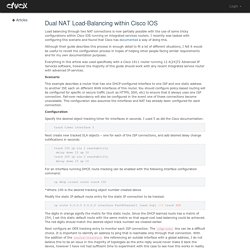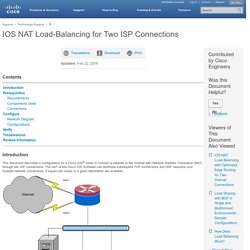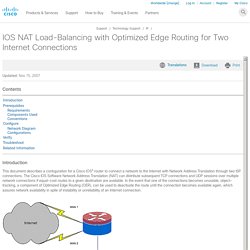

Configuring Static Route Tracking using IP SLA (Basic) In today's network environment, redundancy is one of the most important aspects, whether its on the LAN side or on the WAN side.
In this topic we will be covering WAN redundancy with multiple WAN links terminating on a single router. The best and simplest way to achieve WAN redundancy on Cisco devices is to use Reliable Static backup routes with IP SLA tracking. IP SLAs is a feature included in the Cisco IOS Software that can allow administrators the ability to Analyze IP Service Levels for IP applications and services. IP SLA's uses active traffic-monitoring technology to monitor continuous traffic on the network. This is a reliable method in measuring over head network performance. With IP SLAs, routers and switches perform periodic measurements. Users interested can head to our Cisco Routers section where they can find a number of articles covering IP SLA configuration on Cisco routers. Let us take an example of a basic redundant WAN link scenario as shown below: R1# show track.
Solved: CISCO 800 - dual WAN switching using IP... We have a CISCO 800 series connected to 2 WAN channels, and 2 VLANs.

The idea is to have VLAN1 always use WAN1 channel, and VLAN2 use WAN2 channel, but in case of connectivity failure switch to a working channel. Important to say that both WANs use DHCP-assigned IP addresses, so it's not possible to determine next-hop IP address etc.. Default gateways can change from time to time. I got some problems with realizing this and will greatly appreciate your help: First some config: interface FastEthernet8 <---- WAN 2 ip address dhcp ip nat outside ip virtual-reassembly in duplex auto speed auto!
Interface GigabitEthernet0 <----- WAN 1 ip address dhcp ip nat outside ip virtual-reassembly in duplex auto speed auto! Interface Vlan1 <---------- VLAN 1 description LAN interface ip address 192.168.244.1 255.255.255.0 ip nat inside ip virtual-reassembly in ip policy route-map VLAN1LAN! Here are the route-maps and access-lists: ISP Failover with Default Routes using IP SLA Tracking. Introduction This document describes how to configure WAN (or ISP) redundancies, wherein multiple WAN links terminate on the same end router.
This document also explains how to configure Network Address Translation (NAT) when there are multiple ISP's for internet connectivity and you want seamless failover i.e. when Primary ISP goes down then Secondary takes over with correct NAT with the use of the secondary ISP's public IP address. Prerequisites Requirements There are no specific requirements for this document. Components Used This document is not restricted to specific software and hardware versions. Dual NAT Load-Balancing within Cisco IOS. Load balancing through two NAT connections is now partially possible with the use of some tricky configurations within Cisco IOS running on integrated services routers.

I recently was tasked with configuring this scenario and found that Cisco has documented a way of doing this. Although their guide describes this process in enough detail to fit a lot of different situations, I felt it would be useful to revisit the configuration process in hopes of helping other people facing similar requirements and for my own documentation purposes. Everything in this article was used specifically with a Cisco 1811 router running 12.4(24)T2 Advanced IP Services software, however the majority of this guide should work with any recent integrated service router with advanced IP services. Scenario. Isw cef load balancing. Configuring Static Route Tracking using IP SLA (Basic) IOS NAT Load-Balancing for Two ISP Connections. Introduction This document describes a configuration for a Cisco IOS® router to connect a network to the Internet with Network Address Translation (NAT) through two ISP connections.

The NAT of the Cisco IOS Software can distribute subsequent TCP connections and UDP sessions over multiple network connections, if equal-cost routes to a given destination are available. Prerequisites Requirements This document assumes you start to work with LAN and WAN connections, and does not provide configuration or troubleshooting background to establish initial connectivity. Components Used This configuration was developed with the use of a Cisco 1811 router with Cisco IOS Software Release 12.4(15)T3 Advanced IP Services software. The information in this document was created from the devices in a specific lab environment. Conventions Refer to Cisco Technical Tips Conventions for more information on document conventions. Configure Network Diagram. IOS NAT Load-Balancing with Optimized Edge Routing for Two Internet Connections.
Introduction This document describes a configuration for a Cisco IOS® router to connect a network to the Internet with Network Address Translation through two ISP connections.

The Cisco IOS Software Network Address Translation (NAT) can distribute subsequent TCP connections and UDP sessions over multiple network connections if equal-cost routes to a given destination are available. In the event that one of the connections becomes unusable, object-tracking, a component of Optimized Edge Routing (OER), can be used to deactivate the route until the connection becomes available again, which assures network availability in spite of instability or unreliability of an Internet connection. Prerequisites Requirements This document assumes that you have functional LAN and WAN connections; it does not provide configuration or troubleshooting background to establish initial connectivity. Components Used The information in this document was created from the devices in a specific lab environment.
Verify. Load balancing by equal cost Static Routes. Dual ISP connection and load balancing. Cisco CEF 2 ISP load balancing. IP Switching Cisco Express Forwarding Configuration Guide, Cisco IOS Release 15M&T - Configuring a Load-Balancing Scheme [Cisco IOS 15.4M&T] Adjacency --A relationship formed between selected neighboring routers and end nodes for the purpose of exchanging routing information.
![IP Switching Cisco Express Forwarding Configuration Guide, Cisco IOS Release 15M&T - Configuring a Load-Balancing Scheme [Cisco IOS 15.4M&T]](http://cdn.pearltrees.com/s/pic/th/configuration-configuring-145036561)
Adjacency is based upon the use of a common media segment by the routers and nodes involved. Cisco Express Forwarding --A Layer 3 switching technology. Cisco Express Forwarding can also refer to central Cisco Express Forwarding mode, one of two modes of Cisco Express Forwarding operation. Cisco Express Forwarding enables a Route Processor to perform express forwarding. Distributed Cisco Express Forwarding is the other mode of Cisco Express Forwarding operation. distributed Cisco Express Forwarding --A mode of Cisco Express Forwarding operation in which line cards (such as Versatile Interface Processor [VIP] line cards) maintain identical copies of the forwarding information base (FIB) and adjacency tables. FIB --forwarding information base.
LSP --label switched path. Prefix --The network address portion of an IP address.